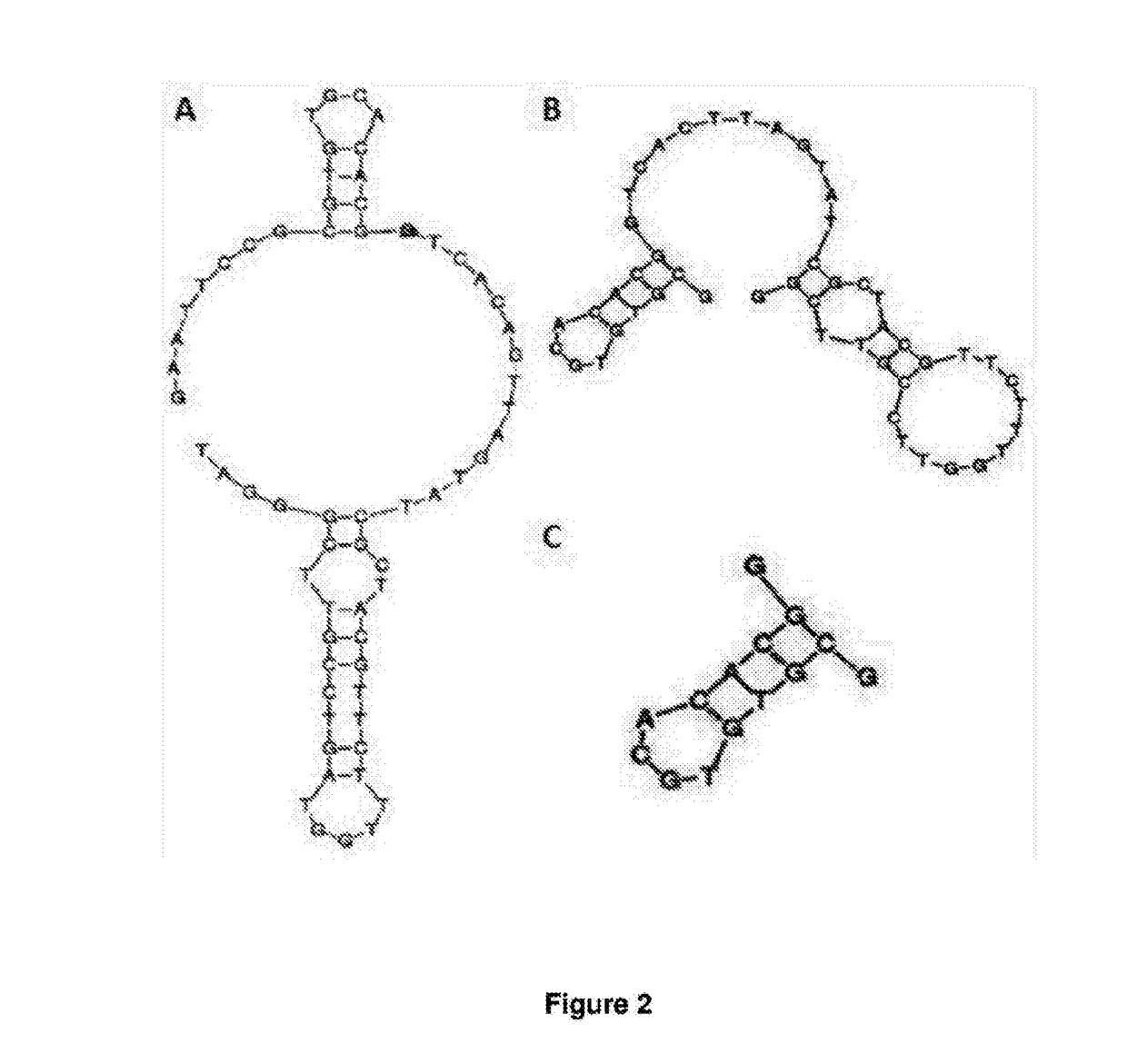Epcam aptamers and conjugates thereof
a technology of aptamers and conjugates, applied in the field of epcam aptamers and epcam aptamer conjugates, can solve the problems of tumour cell death, affecting the effectiveness of antibodies in the treatment of brain tumours, and compromising the ability to pass the blood brain barrier, so as to achieve effective targeting of brain metastases and/or brain tumours, reducing the effect of tumour cell death and reducing the siz
- Summary
- Abstract
- Description
- Claims
- Application Information
AI Technical Summary
Benefits of technology
Problems solved by technology
Method used
Image
Examples
example 1
Characterisation of Anti-Transferrin Receptor Aptamers
[0219](i) TfR Aptamer generation
[0220]The transferrin aptamers generated herein were derived from an aptamer against mouse transferrin receptor (tfR) as previously described in Chen et al (2008) PNAS 105(41):15908-13 and shown in FIG. 3A and B. This original aptamer design was used as a proof-of-concept for the transcytosis of an aptamer through the BBB. The inventors further truncated the original TfR aptamer of Chen et al and having the sequence 5′ GAATTCCGCGTGTGCACACGCTCACAGTTAGTATCGCTACGTTCTTTGGTAGTCCGTTCG GGAT 3′ (SEQ ID NO:15) aptamer to generate the TfR aptamer (FIG. 2C and SEQ ID NO:4)). This was then subsequently modified via the scrambling of the sequence of the binding loop to produce three alternate versions (designated TfR2, TfR3 and TfR4) as shown in Table 2. The 2D structure of the anti-TfR aptamers was predicted with the VIENNA software (Gruber AR et al (2008) Nucleic Acids Research 36(Web server issue):W70-W4 so ...
example 2
Characterisation of EpCAM Aptamers
[0231]The SYL3C (Full length or FL) 48 mer aptamer was originally generated by Song et al (2013) Analytical Chemistry 85:4141-4149. 2D structures were predicted using RNAfold. Truncated versions of this aptamer designated Ep7, Ep8 and Ep9 respectively were generated as shown in Table 2 and FIG. 4. Sequences of the extended Ep7 and scrambled extended Ep7 aptamers are shown in Table 2. The extended Ep7 has the same binding loop as Ep7 and the scrambled extended Ep7 has randomly selected base pairs in the binding loop. 2D structures were predicted using RNAfold (Gruber AR et al. (2008) The Vienna RNA websuite. Nucleic acids Research 36:W70-W4.
[0232]All aptamers including truncated Ep7, Ep8, Ep9, Extended (Ex) ExEp7, and Scrambled (Scr) ScrEx Ep7 were commercially synthesized (Integrated DNA Technologies) with a TYE665 dye at the 5′ end and an inverted thymidine at the 3′ end.
i) Determination of Binding Affinity
[0233]The equilibrium dissociation constan...
example 3
Characterisation of Conjugate Aptamers
[0247](i) Conjugate aptamers
[0248]An aptamer against EpCAM had previously been generated by Song et al (2013) Analytical Chemistry 85:4141-4149. A truncated version of this (designated Ep7, Table 2), which had previously been characterised in the inventor's lab, was used to conjugate with the anti-TfR aptamers in order to produce three bi-specific aptamers for characterisation. The sequences of the bifunctional aptamers are shown in Table 2. The binding loops of each of TfR and Ep7 were scrambled. Bi1 was based on TfR1 and Ep7, Bi2 was based on TfR2 and Ep7 and Bi3 was based on TfR3 and Ep7.
[0249]Minor changes were made in the stem region to increase the number of GC pairs, in anticipation of the intercalation of the aptamers with doxorubicin. The 2D structure of the bi-specific aptamers was determined, again, with the VIENNA software in order to establish whether or not the shape of the two original aptamers was retained in the conjugate.
(ii) D...
PUM
| Property | Measurement | Unit |
|---|---|---|
| equilibrium dissociation constants | aaaaa | aaaaa |
| equilibrium dissociation constants | aaaaa | aaaaa |
| equilibrium dissociation constant | aaaaa | aaaaa |
Abstract
Description
Claims
Application Information
 Login to View More
Login to View More - R&D
- Intellectual Property
- Life Sciences
- Materials
- Tech Scout
- Unparalleled Data Quality
- Higher Quality Content
- 60% Fewer Hallucinations
Browse by: Latest US Patents, China's latest patents, Technical Efficacy Thesaurus, Application Domain, Technology Topic, Popular Technical Reports.
© 2025 PatSnap. All rights reserved.Legal|Privacy policy|Modern Slavery Act Transparency Statement|Sitemap|About US| Contact US: help@patsnap.com



